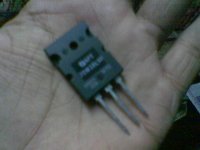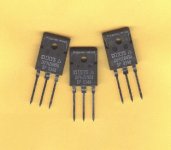djk said:WOW!
40W SOA at 100V!
If SOA is the only criteria one should use while selecting components then I say double wow!
djk said:WOW!
40W SOA at 100V!
Hmmm...... check out MJL21194. 1.7A@100V, which means 170W SOA.
Triplewow????? 😀
sajti
sajti said:
Hmmm...... check out MJL21194. 1.7A@100V, which means 170W SOA.
Triplewow????? 😀
sajti
Satji and triple-S.... the wow factor was done in jest.

Also we all know of djk's affection for the mj21193/4 's SOA at 100v. 😉
Lastly if you read my post agin, you will see I was discretely "dis-agreeing" with djk's emphasis on SOA as being an over bearing criteria for selection of devices.... 4X WOW!
K-amps said:
Satji and triple-S.... the wow factor was done in jest.
Also we all know of djk's affection for the mj21193/4 's SOA at 100v. 😉
Lastly if you read my post agin, you will see I was discretely "dis-agreeing" with djk's emphasis on SOA as being an over bearing criteria for selection of devices.... 4X WOW!
OK I read Your post again. 😀
So I think that SOA is one of the most important parameter for power BJTs. I made 60W/8ohm amplifier for one of my friend. It use BC546/556 as input LTP, MPSA42/92 as VAS and predriver, MJE15030/31 as drivers, and MJL21193/94 as output. I made it for +/-40V. But he got another transformer (800VA 2x37V secondary), he changed the capacitors, use fan cooling and the amplifier now gives about 210W for 4ohms with one pair output device😱 This amplifier spent 1 year in my friend's dancing club, and it still works...
sajti
Solid Snake said:I like the TIP35 and TIP36. 125w of dissipation and I have yet to blow one up.
I used BD249/250 which equal to TIP35/36.I made lot of amplifier with them, but I guess that today much better devices are available...
sajti
My God I had a hearty laugh reading those Wow , Wow Wow , Wow Wow Wow and finaly Holy Cow , You guys really have a sence of humour.
Looking at the hfe of the output and driver devices I wonder if I can get away with a darlington of two transistors instead of a treple darlington in the output stage . These devices really have very good gain .
Looking at the hfe of the output and driver devices I wonder if I can get away with a darlington of two transistors instead of a treple darlington in the output stage . These devices really have very good gain .
rajeev luthra said:My God I had a hearty laugh reading those Wow , Wow Wow , Wow Wow Wow and finaly Holy Cow , You guys really have a sence of humour.
Looking at the hfe of the output and driver devices I wonder if I can get away with a darlington of two transistors instead of a treple darlington in the output stage . These devices really have very good gain .
That is certainly a worthy idea.... with better devices available these days, one should look at ways to reduce component count.
I see a day, when we will have an Output device, that will have sufficient gain to be connected to the pre-amp directly with little associated supporting circuitry.

I just finished designing a modified Slone "11.4" amp based on the MJW21193/4 pair, and I'm pleased as punch with them.
I come from an engineering background so I'm not about to start talking about creamy delicious caramel highs and musicians that leapt out of the soundstage and kicked me in the face, but I can say that Audio Precision gear likes the amp. So these transistors don't seem to be any sort of limiting factor in the design.
And these transistors can take a beating! I've square-wave tested this amp into a short circuit - the overcurrent protection isn't instantaneous so the transistors are getting blasted with quick power pulses whenever the input signal swings. But they just shrug it off...
I wouldn't call these transistors my 'favorites' quite yet, but I can't say anything bad about 'em.
I come from an engineering background so I'm not about to start talking about creamy delicious caramel highs and musicians that leapt out of the soundstage and kicked me in the face, but I can say that Audio Precision gear likes the amp. So these transistors don't seem to be any sort of limiting factor in the design.
And these transistors can take a beating! I've square-wave tested this amp into a short circuit - the overcurrent protection isn't instantaneous so the transistors are getting blasted with quick power pulses whenever the input signal swings. But they just shrug it off...
I wouldn't call these transistors my 'favorites' quite yet, but I can't say anything bad about 'em.
Hi ampman,
I think I can say "" Balle Balle "" Chack de Fathe ""
For others
above is something like wow in punjabi a north Indian Language
Ampman why not float an amp design with the above device like the other great amp designers
Cheers
I think I can say "" Balle Balle "" Chack de Fathe ""
For others
above is something like wow in punjabi a north Indian Language
Ampman why not float an amp design with the above device like the other great amp designers
Cheers
I see a day, when we will have an Output device, that will have sufficient gain to be connected to the pre-amp directly with little associated supporting circuitry
Hmm....Lm3875?!? etc. etc.

- Status
- Not open for further replies.
- Home
- Amplifiers
- Solid State
- Favorite High Power Output Transistor



 No Chips please.....
No Chips please.....